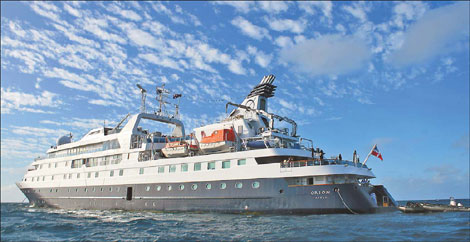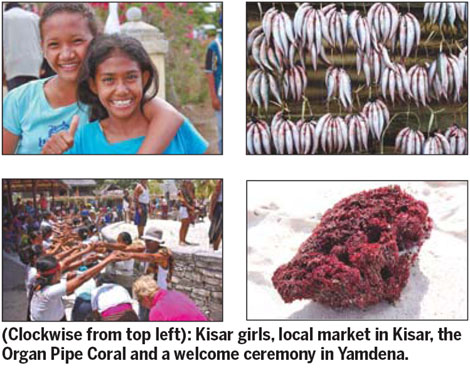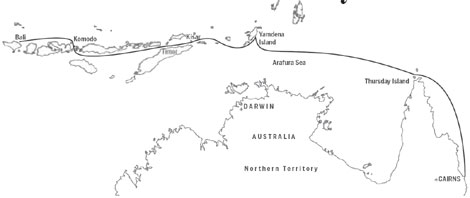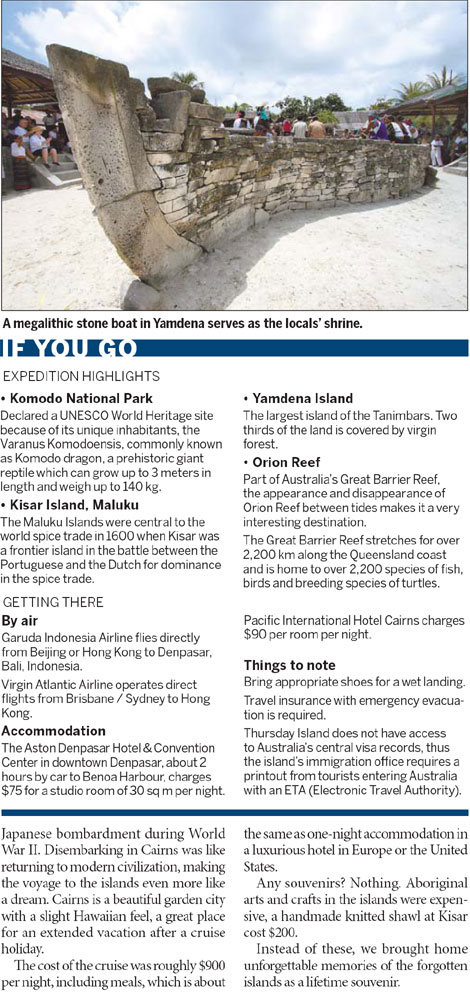Bali bon voyage
By Sindy Chan (China Daily)
Updated: 2010-05-06 10:44
 |
Large Medium Small |



A cruise from Bali to Cairns is a timeless journey through far-flung romantic isles of dragons, spices and coral. Sindy Chan reports
After about 20 undulating minutes the Zodiac, our transfer between the cruise ship and shore, landed on Orion Reef, one of 300 coral reef cays in Australia's Great Barrier Reef and one that is only exposed at low tide.
"Let's be the first Zodiac to land," said David Silverberg, a marine biologist and a guest lecturer on our cruise.
It was Silverberg who was the first to dive into the azure waters for his up close and personal rendezvous with sharks and colorful reef fish. My family just enjoyed being in the middle of nowhere, enjoying the music of the breeze and waves, reveling in the essence of an expedition cruise: sailing across the ocean to places less traveled and accessible only by sea.
We were on a 11-day Bali-Cairns expedition cruise, hopping the Indonesian islands of Komodo, Kisar and Yamdena, then sailing southward to the Australian Thursday Island, Torres Strait and the Great Barrier Reef.
It was a surprise that many passengers were repeat customers. Peter Moffett, a World War II pilot, was traveling for the fifth time.
"Land travel involves too much packing and unpacking. Travelers of my age prefer adventure in comfort," Moffett explained.
Our journey began with a golden sunset in Bali, triggering the notion that we were following in the footsteps of early explorers to lands of mystery and destinations unknown.
The Pink Beach of the Komodo Islands was a romantic highlight of the trip. If not for a few locals trying to sell arts and crafts, it was possible to imagine that we had found a lost horizon of Organ Pipe Coral, whose reddish crushed particles had tinted the sandy beach pink.
Then full of anticipation, we arrived at Loh Liang, the entry point of Komodo National Park. We were divided into groups of 10, each group escorted by two park rangers and one expedition staff.
"For safety and forest conservation reasons, please walk on the trails only, stay between me in the front and my partner at the back," said our sharp-eyed ranger, who was armed with a long stick.
"Komodo dragons are dangerous. I have seen a slow-moving dragon suddenly turning very fast to attack," the ranger warned, as we detoured to get a closer look at the small group of Komodo dragons we encountered bathing in the sun.
The Komodo dragon is an endangered species of prehistoric reptile with an estimated population of less than 5,000. Walking into its habitat reminded me that humans are the guests of nature, not its hosts.
Our morning tour of the ancient East Indies Kisar Island was a stark contrast between the past and present.
The official welcome ceremony at Government House and the visit to the early 20th century Rajah's House were memorable not least for the traditional red costumes and headdresses.
Spice is a constant in Kisar. In the local market, fragrance of nutmeg still prevails since the time the island became known for the spice in the 17th century.
We had an unexpected rough landing in Yamdena. Arriving at low tide, we had to negotiate a shallow reef for some distance before landing. A village elder in traditional costume and modern sunglasses presided over a welcome dance. Then we climbed a steep antique stairway of around 50 meters to reach Sangliat Dol, a village built at high elevation to keep it safe from flooding.
Time seems to have come to a halt here. Yamdena's people still make a living from gathering fruits and honey, growing beans and coconuts and fishing, just as their ancestors have done for generations.
A megalithic stone boat in the village center serves as the locals' shrine. In the Tanimbar Islands, which include Yamdena, locals believe that the village chief and elders are the crew of a boat and the villagers are its passengers.
As the cruise ship passed the Gulf of Carpentaria to reach Cape York, passengers were all ready with their binoculars to check the Cape York sign identifying the northernmost tip of the Australian continent. But expedition leader Justin Friend had a disappointment in store.
"The Cape York sign which stood for 20 years at the top of Cape York has gone," Friend said. "It might have been stolen by some souvenir hunting tourists."
It was a quiet town that we encountered on Thursday Island on a Sunday morning. Strong winds and dazzling sun could explain why there were more tourists than locals on the street.
The past glory of Thursday Island could not be easily felt as we strolled around the town. But the small island holds strategic importance as the northernmost town of Australia. It was once home to a substantial Japanese population in 1885 when the pearl industry flourished there.
The cemetery on the island, where hundreds of Japanese pearl divers are buried, was believed to have saved the town from Japanese bombardment during World War II. Disembarking in Cairns was like returning to modern civilization, making the voyage to the islands even more like a dream. Cairns is a beautiful garden city with a slight Hawaiian feel, a great place for an extended vacation after a cruise holiday.
The cost of the cruise was roughly $900 per night, including meals, which is about the same as one-night accommodation in a luxurious hotel in Europe or the United States.
Any souvenirs? Nothing. Aboriginal arts and crafts in the islands were expensive, a handmade knitted shawl at Kisar cost $200.
Instead of these, we brought home unforgettable memories of the forgotten islands as a lifetime souvenir.
